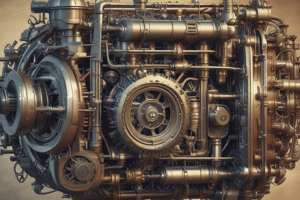Podcast
Questions and Answers
What is the purpose of the Otto cycle exercise?
What is the purpose of the Otto cycle exercise?
- To sketch the four processes of the Otto air standard cycle (correct)
- To determine the heat added per kilogram in the Diesel cycle
- To derive the efficiency of the Otto air standard cycle
- To calculate the thermal efficiency of the Diesel cycle
What is the compression ratio of the Otto cycle in the given exercise?
What is the compression ratio of the Otto cycle in the given exercise?
- 7.5
- 8.7 (correct)
- 15
- 20
What is the initial temperature of the air in the Otto cycle?
What is the initial temperature of the air in the Otto cycle?
- 1 c° (correct)
- 3300 c°
- 100 c°
- 20 c°
What is the heat added in the Otto cycle?
What is the heat added in the Otto cycle?
What is the maximum temperature in the Diesel cycle?
What is the maximum temperature in the Diesel cycle?
What is the initial pressure of the air in the Otto cycle?
What is the initial pressure of the air in the Otto cycle?
What is the compression ratio of the Diesel cycle mentioned in the problem?
What is the compression ratio of the Diesel cycle mentioned in the problem?
What is the maximum temperature of the Otto cycle mentioned in the problem?
What is the maximum temperature of the Otto cycle mentioned in the problem?
What is the power produced by the internal combustion engine working on the Otto cycle?
What is the power produced by the internal combustion engine working on the Otto cycle?
What is the temperature at the beginning of the compression process in the Diesel cycle?
What is the temperature at the beginning of the compression process in the Diesel cycle?
What is the compression ratio of the Otto cycle mentioned in the problem?
What is the compression ratio of the Otto cycle mentioned in the problem?
What is the temperature at the end of the expansion process in the Diesel cycle?
What is the temperature at the end of the expansion process in the Diesel cycle?
Flashcards are hidden until you start studying
Study Notes
Otto Air Standard Cycle
- Four processes:
- Process 1-2: Isentropic compression
- Process 2-3: Constant volume heat addition
- Process 3-4: Isentropic expansion
- Process 4-1: Constant volume heat rejection
P-V and T-S Diagrams for Otto Cycle
- P-V diagram: rectangular shape with four corners representing the four processes
- T-S diagram: four processes plotted with temperature on the y-axis and entropy on the x-axis
Diesel Air Standard Cycle
- Four processes:
- Process 1-2: Isentropic compression
- Process 2-3: Constant pressure heat addition
- Process 3-4: Isentropic expansion
- Process 4-1: Constant volume heat rejection
P-V and T-S Diagrams for Diesel Cycle
- P-V diagram: rectangular shape with four corners representing the four processes
- T-S diagram: four processes plotted with temperature on the y-axis and entropy on the x-axis
Efficiency of Otto Air Standard Cycle
- Efficiency is a function of compression ratio (r)
- Efficiency = 1 - (1/r)^(γ-1), where γ is the adiabatic index
Problem 1: Otto Cycle with Given Conditions
- Given conditions: compression ratio (r) = 8.7, initial state (P1, T1) = (1 kp/cm2, 1 c°), heat added (Q) = 870 kcal/kg
- To determine:
- Pressure, volume, and temperature at the beginning of each process
- Net work (W)
- Thermal efficiency (η)
Problem 2: Diesel Cycle with Given Conditions
- Given conditions: compression ratio (r) = 15, initial conditions (P1, T1) = (1 kp/cm2, 20 c°), maximum temperature (Tmax) = 3300 c°
- To determine:
- Heat added per kilogram (Q)
- Heat rejected per kilogram (Q_rej)
- Net work (W)
- Thermal efficiency (η)
- P-V and T-S diagrams
Problem 3: Air Standard Cycles with Given Conditions
- Two cycles:
- Diesel cycle: compression ratio (r) = 20, cut-off ratio (ρ) = 8, maximum temperature (Tmax) = 1700 K°
- Otto cycle: compression ratio (r) = 8, maximum pressure (Pmax) = 60 kp/cm2 abs
- To determine:
- Thermal efficiency (η) and temperature at each corner for both cycles
Problem 4: Internal Combustion Engine on Otto Cycle
- Given conditions: compression ratio (r) = 8, power produced (P) = 12 horsepower
- To determine:
- Rate of heat added (Q_dot) and rate of heat rejected (Q_rej_dot)
Problem 5: Air Standard Diesel Cycle
- Given conditions: compression ratio (r) = 12, maximum temperature (Tmax) = 1500 K°, temperature at beginning of compression (T1) = 300 K°, temperature at end of expansion (T4) = 700 K°
- To determine:
- Thermal efficiency (η) and P-V diagram for the cycle
Studying That Suits You
Use AI to generate personalized quizzes and flashcards to suit your learning preferences.





